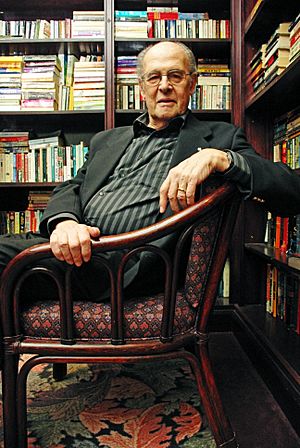Ronald Melzack facts for kids
Quick facts for kids
Ronald Melzack
|
|
|---|---|
 |
|
| Born | July 19, 1929 |
| Died | December 22, 2019 (aged 90) Montreal, Quebec, Canada
|
| Nationality | Canadian |
| Alma mater | McGill University |
| Occupation | Psychologist, Professor |
Ronald Melzack (July 19, 1929 – December 22, 2019) was a Canadian psychologist and professor. He taught at McGill University in Montreal. He is famous for his important work on how we feel pain.
In 1965, he and Patrick David Wall came up with a new idea called the gate control theory of pain. This idea changed how scientists understood pain. Later, in 1968, Melzack explained that pain is not just a simple feeling. It's a complex experience that involves many parts of the brain.
In the 1970s, he created the McGill Pain Questionnaire. This tool helps doctors understand how much pain a person is feeling. He also helped start the International Association for the Study of Pain. This group brings together experts who study pain.
Melzack received many awards for his work. These include the Order of Canada and the Grawemeyer Award. His research helped many people who suffer from pain.
Contents
Early Life and Learning
Ronald Melzack was born in Montreal, Canada. His father worked in a clothing factory and later opened a bookstore. Ron grew up in a busy neighborhood.
His family faced money problems, so Ron was the only one of his siblings to go to university. His brothers worked in the family bookstore, which became a successful chain. Ron studied at McGill University. He earned his first degree in 1951 and his Ph.D. in 1954.
His teacher, Donald O. Hebb, helped him with his Ph.D. research. Hebb was studying dogs that had not grown up normally. Ron noticed that these dogs reacted strangely to pain. For example, they would put their noses in a flame many times. This made Ron very interested in how pain works.
Understanding Pain
After finishing his studies, Melzack started working with patients. Many of these patients had "phantom limb" pain. This means they felt pain in an arm or leg that was no longer there. He learned that pain is not always helpful. Sometimes, pain can be much stronger than the actual injury. It can also last long after the body has healed.
Melzack started collecting "pain words." He grouped words that meant similar things, like "hot," "burning," and "searing." This work led to a very important tool.
The McGill Pain Questionnaire
In 1975, Melzack created the McGill Pain Questionnaire. This questionnaire asks people to describe their pain using many different words. It helps doctors understand exactly what kind of pain a person is feeling. Today, this questionnaire is used in hospitals and clinics all over the world. It helps doctors treat pain better.
The Gate Control Theory
Melzack met Dr. Patrick Wall at the Massachusetts Institute of Technology (MIT). They both thought about pain in new ways. They noticed that some people felt a lot of pain from small injuries. Others with big injuries felt little pain at first.
In 1965, Melzack and Wall developed the gate control theory of pain. This theory suggests that our brains have a "gate" that can open or close. This gate controls how much pain signals reach the brain. Past experiences and thoughts can affect this gate. For example, if you are distracted, the gate might close a bit, and you feel less pain.
This theory also led to the discovery of endorphins. Endorphins are natural chemicals in our bodies that can block pain. They are like our body's own pain relievers.
The Neuromatrix Theory
Melzack also developed the neuromatrix theory. This idea suggests that we are born with a special network in our brain. This network creates our sense of our body and ourselves. It can also create feelings of chronic pain, even if there is no injury. This means pain is not just about the body part that hurts. It's also about how our brain processes those signals.
Different Types of Pain
Melzack's research showed that there are two main types of pain. Each type uses different pathways in the brain:
- Sudden, short-term pain: Like when you cut your finger. This pain travels through a "lateral" system in the brain.
- Long-lasting pain: Like chronic back pain. This pain travels through a "medial" system in the brain.
Understanding these different pathways helps scientists develop better ways to treat different kinds of pain.
Helping Patients
In 1974, Melzack helped start the first pain clinic in Canada. It was at the Montreal General Hospital. He was the research director there for many years. This clinic became a very important center for treating pain.
Melzack also taught many students at McGill University. One of his students, John O'Keefe, later won the Nobel Prize in Physiology or Medicine for his own brain research.
Awards and Honors
Ronald Melzack received many important awards for his work:
- He was a founding member of the International Association for the Study of Pain (IASP). He also served as its president.
- He was made a member of the Canadian Medical Hall of Fame.
- He became a Fellow of the Royal Society of Canada in 1982.
- In 1994, he received the Prix du Québec. This is the highest honor for a scientist in his home province.
- In 1995, he was made an Officer of the Order of Canada. This is one of Canada's highest honors.
- In 2000, he became an Officer of the National Order of Quebec.
- He won a Killam Prize in 2001.
- In 2010, he received the Grawemeyer Award for his studies on pain.
His work changed how doctors and scientists understand and treat pain. He helped improve the lives of many people around the world.

